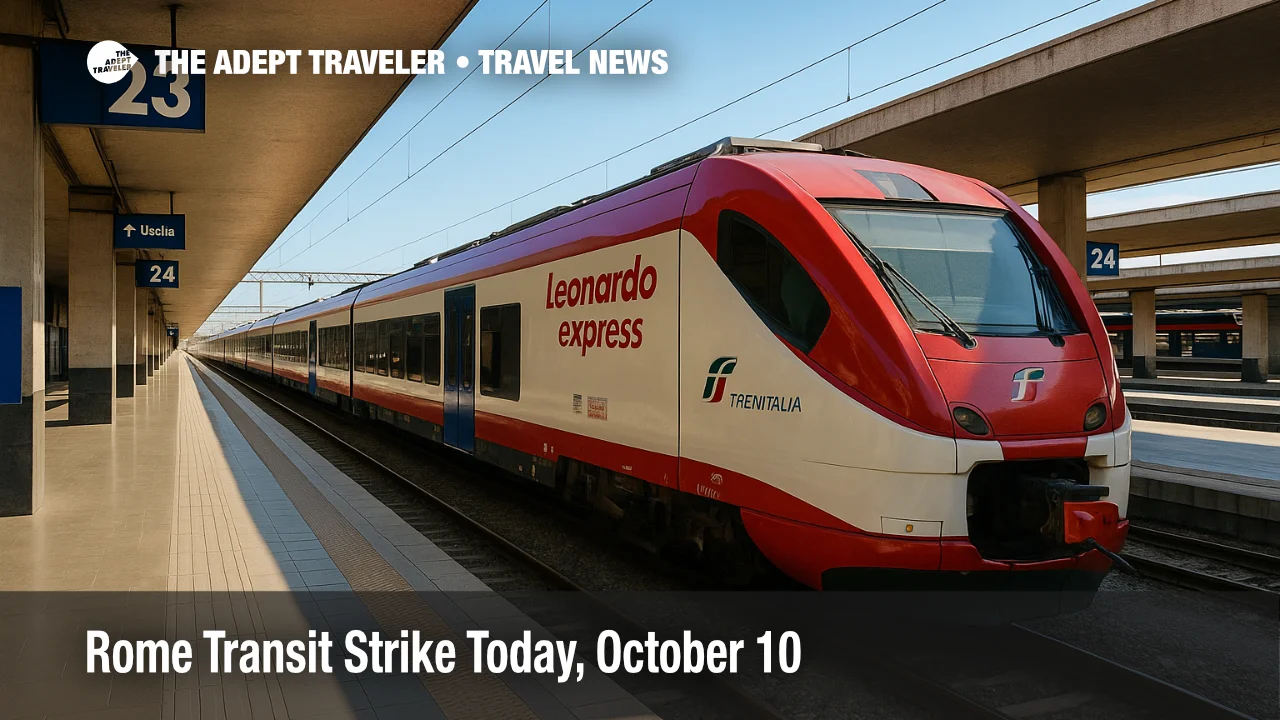Rome Transit Strike Today, October 10

A 24-hour ATAC strike on Friday, October 10 is disrupting Rome's metro, bus, tram, and the Termini-Centocelle rail. Service is guaranteed only in Italy's protected time bands, with reduced or suspended service at other hours. Travelers headed to or from Rome Fiumicino Airport (FCO) should favor rail options that sit outside ATAC's control and build in extra time between Roma Termini and the airport.
Key points
- Why it matters: Metro, bus, tram, and Termini-Centocelle face daylong slowdowns outside protected bands.
- Travel impact: Expect longer waits, crowding, and sporadic trip cancellations across ATAC routes.
- What's next: ATAC and Roma Mobilità will post day-of updates as staffing and service fluctuate.
- Protected bands: Start of daytime service-829 a.m., and 500-7:59 p.m. on October 10.
- Airport plan: Use Leonardo Express or FL1; avoid ATAC buses for airport transfers during off-peak hours.
- Ticketing: Station ticket windows may be limited; buy rail tickets in apps or online when possible.
Snapshot
Two overlapping labor actions hit ATAC on October 10: a 24-hour strike by SUL and a four-hour action from 830 a.m. to 1230 p.m. by USB Lavoro Privato and ORSA TPL. Under Rome's strike rules, service is guaranteed until 829 a.m. and again from 500 to 7:59 p.m. Outside those windows, riders should plan for cut frequencies or pauses on Metro A, B/B1, and C, surface buses and trolleybuses, trams, and the Termini-Centocelle line. Regional providers Trenitalia and Cotral are not part of this walkout, preserving rail links to FCO. For airport transfers, prioritize the Leonardo Express from Roma Termini or the FL1 from Roma Tiburtina, Roma Ostiense, or Trastevere, and allow extra time for station crowds and platform queues.
Background
ATAC, Rome's municipal transit operator, periodically faces industrial actions over working conditions and staffing. Italian law mandates "fasce di garanzia," protected windows that keep essential commuter travel running, typically the early morning and late afternoon bands. During ATAC-only strikes, Rome's state-run rail services continue, which is why airport trains are the most reliable option for flyers. The Leonardo Express provides a nonstop Roma Termini-FCO link in about 32 minutes, while the FL1 regional line connects FCO to key city stations, including Roma Tiburtina and Roma Trastevere. On strike days, riders should expect heavier evening crowds as travelers shift into the protected 500-759 p.m. band.
Latest developments
Protected time bands, what typically runs, and where the gaps are
ATAC confirms two actions on October 10: a 24-hour SUL strike and a separate four-hour action from 830 a.m. to 1230 p.m. Roma Mobilità reiterates that ATAC service is guaranteed from the start of daytime operations until 829 a.m., and again from 500 to 7:59 p.m. Outside those bands, expect reduced or suspended trips on Metro A/B/B1/C, buses, trolleybuses, trams, and the Termini-Centocelle line. Some lines operated by subcontractors may be excluded, but riders should verify day-of notices. Regional Cotral buses and Trenitalia trains are scheduled to run normally, which helps maintain connectivity for airport transfers and city-to-city travel.
Best Rome Fiumicino (FCO) transfers during the strike
For FCO, favor rail over surface transit. Take the Leonardo Express from Roma Termini for a nonstop 32-minute ride, departing roughly every 15 minutes, or use FL1 from Roma Tiburtina, Roma Trastevere, or Roma Ostiense with frequent service on working days. These trains are operated by Trenitalia, not ATAC, and are expected to run on a normal timetable. Buy tickets via Trenitalia's app or machines to avoid possible staffing limits at some ticket offices. If you must ride during off-band hours, budget an extra 30-45 minutes station-to-gate at Termini, and more in the evening peak when crowding typically increases.
Metro station access, crowds, and evening buffers
During midday and late-evening off-band periods, Metro A/B/C frequencies can thin, creating crowding at gates and on platforms. Station staff may meter entries if platforms become congested. Build transfer buffers between Termini and FCO, especially for flights departing in the early evening. If you cannot align with the 500-759 p.m. protected window, shift to the Leonardo Express or FL1 earlier than usual, and complete last-mile connections by foot or licensed taxi where feasible.
Analysis
For air travelers, the practical risk on October 10 is not reaching FCO on time. Because ATAC controls metro, bus, tram, and Termini-Centocelle services, the biggest variability sits on those modes. Protected windows offer a reliable spine, but the middle of the day and late evening can see uneven headways and sudden cancellations. By contrast, Trenitalia's airport links run independently of ATAC, which substantially lowers disruption risk. The Leonardo Express is the most time-certain option between Termini and FCO; FL1 is a strong value from Tiburtina, Ostiense, or Trastevere, with easy connections to long-distance trains. You should pre-purchase tickets in apps, arrive platformside 10-15 minutes early, and avoid tight connections across Termini concourses. If your itinerary overlaps with the 500-759 p.m. band, expect heavier crowds as riders compress trips into the guaranteed window, and pad schedules accordingly.
Final thoughts
If you keep airport transfers on the Trenitalia network and time city moves inside the protected bands, you can largely sidestep the worst impacts of the Rome transit strike. Prioritize Leonardo Express or FL1, pre-buy tickets, and allow generous buffers at Roma Termini and FCO. With a little planning, the Rome transit strike does not have to derail your day.
Sources
- IL 10 OTTOBRE SCIOPERO RETE ATAC - I DETTAGLI, ATAC
- Venerdì 10 ottobre sciopero in Atac, Roma Mobilità
- Trasporto pubblico a rischio il 10 ottobre, Roma Mobilità (update page)
- Scioperi calendar, Ministry of Infrastructure and Transport
- Leonardo Express service overview, Trenitalia
- Connections to and from Rome Fiumicino Airport, Trenitalia
- Train to and from FCO, Aeroporti di Roma
- Rome faces public transport strike on Friday 10 October, Wanted in Rome
